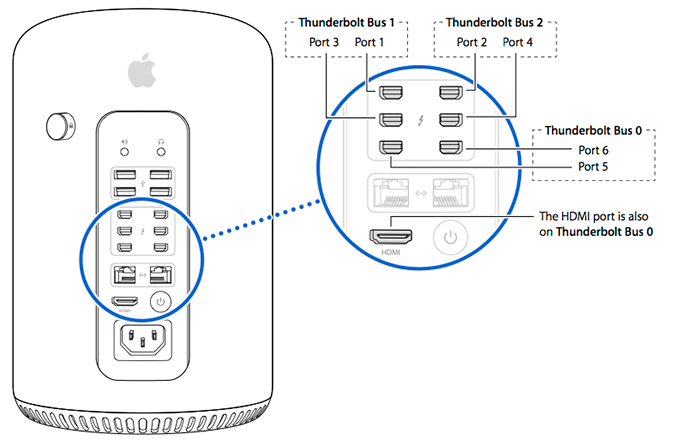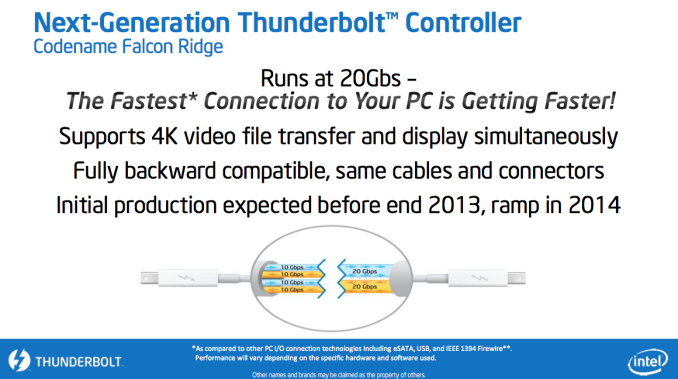The Mac Pro Review (Late 2013)
by Anand Lal Shimpi on December 31, 2013 3:18 PM ESTThunderbolt 2
The new Mac Pro integrates three Intel Falcon Ridge Thunderbolt 2 controllers. These are the fully configured controllers, each supporting and driving two Thunderbolt 2 connectors on the back of the Pro for a total of 6 ports.
Pairing Thunderbolt 2 with Ivy Bridge EP is a bit tricky as Apple uses Thunderbolt 2 for display output as well as data. Typically you’d route all display through processor graphics, but in the case of IVB-EP there is no integrated graphics core. On a DIY PC you enable display output over Thunderbolt 2 by running an extra cable out of the discrete GPU and into a separate input that muxes the signal with PCIe and ships it out via another port as Thunderbolt. Here’s where Apple’s custom PCB work comes in handy as all of this is done internal to the Mac Pro. The FirePro’s display outputs are available via any two of the six Thunderbolt 2 ports, as well as the lone HDMI port on the back of the Mac Pro.
How does Thunderbolt 2 differ from the original? For starters, it really would’ve been more accurate to call it Thunderbolt 4K. The interface is fully backwards compatible with Thunderbolt 1.0. You can use all previous Thunderbolt peripherals with the Mac Pro. What’s new in TB2 is its support for channel bonding. The original Thunderbolt spec called for 4 independent 10Gbps channels (2 send/2 receive). That meant no individual device could get access to more than 10Gbps of bandwidth, which isn’t enough to send 4K video.
Thunderbolt 2 bonds these channels together to enable 20Gbps in each direction. The total bi-directional bandwidth remains at 40Gbps, but a single device can now use the full 20Gbps. Storage performance should go up if you have enough drives/SSDs to saturate the interface, but more importantly you can now send 4K video over Thunderbolt. Given how big of a focus 4K support is for Apple this round, Thunderbolt 2 mates up nicely with the new Mac Pro.
So far I’ve been able to sustain 1.38GB/s of transfers (11Gbps) over Thunderbolt 2 on the Mac Pro. Due to overhead and PCIe 2.0 limits (16Gbps) you won’t be able to get much closer to the peak rates of Thunderbolt 2.

The impact of chaining a 4K display on Thunderbolt 2 downstream bandwidth
Here’s where the six Thunderbolt 2 and three TB2 controllers come into play. Although you can daisy chain a 4K display onto the back of a Thunderbolt 2 storage device, doing so will severely impact available write bandwidth to that device. Remember that there’s only 20Gbps available in each direction, and running a 3840 x 2160 24bpp display at 60Hz already uses over 14Gbps of bandwidth just for display. I measured less than 4Gbps of bandwidth (~480MB/s) available for writes to a Thunderbolt 2 device downstream from the Mac Pro if it had a 4K display plugged in to it. Read performance remained untouched since display data only flows from host to display, leaving a full 20Gbps available for reads. If you’re going to connect Thunderbolt 2 devices to the Mac Pro as well as a 4K display, you’ll want to make sure that they aren’t on the same chain.
If we start numbering in the top left corner of the 2 x 3 array of Thunderbolt ports and go left to right down the stack, you'll want to first populate ports 1, 2 and 5 before filling in the rest. The diagram below should help simplify:












267 Comments
View All Comments
JlHADJOE - Wednesday, January 1, 2014 - link
AFAIK the D700 is also a FirePro, and also has ECC on its VRAM.tipoo - Wednesday, January 1, 2014 - link
Wrong, it has no ECC. On OSX Apple writes much of the graphics driver anyways, so they can get away with calling Radeons FirePros as ECC isn't a necessity to call them that.Kevin G - Wednesday, January 1, 2014 - link
ECC on the FirePro's doesn't actually add additional RAM like it does on traditional server DIMM's. Instead as RAID5 like parity is performed on GPU memory channels to be able to be able to detect a memory error. Thus the 6 GB card will only have 5.25 GB available to use with ECC enabled. Since all the memory channel have to be used for a memory access, performance in some workloads takes a significant hit. I believe by default ECC is disabled for performance and memory capacity reasons.There is also one other difference between the D700 and the W9000: clock speeds and voltages. The D700 runs are a lower clock speed by default and presumably lower voltage to cut power consumption.
DaveGirard - Wednesday, January 1, 2014 - link
the D700 is clocked lower than the W9000. It's at 850MHz instead of 950.lilo777 - Wednesday, January 1, 2014 - link
Except it does not have ECC memory or the Pro drivers which are the only things that differentiate Pro from consumer grade cards. As such they are consumers grade cards (and the two year old generation) which cost around $700 at most not the $3500 pro cards.japtor - Wednesday, January 1, 2014 - link
There's never been a pro driver distinction in OS X, Radeons are validated for pro apps in OS X like FirePros in Windows. Granted there hasn't been the pro branding until now, but Apple does the drivers iirc so I don't see them bothering with splitting the driver base like AMD does.melgross - Wednesday, January 1, 2014 - link
You know nothing about Apple's drivers. I would bet that at the very least, they are based on the pro driver configurations, as apple has little interest in gaming, and a lot of interest in pro users. If you look at the performance of this in a pro app you can see that performance is pretty good. Mac Pro's are used in NASA, drug company research labs, CAD shops, video, photography labs and studios and publishing. Game drivers are of no interest to them.solipsism - Tuesday, December 31, 2013 - link
Note that he speculates that the CPU would be soldered (something no Mac Pro has ever had) and the thermal cap removed (something I believe Apple had only done once).Also note he doesn't have any more PCIe available for the SSD so he ends up going with the much slower SATA version but to make up some of the speed he gets 2x512GB in a RAID 0 configuration.
I like the case they used and I'm expect to see *more* of these smaller cases hit the market for DIYer and from OEMs now that Apple has stepped in.
Lonyo - Wednesday, January 1, 2014 - link
There are lots of small cases on the market and there have been for a while now... sure there could be more, but they are already widely available with a hell of a lot of variety of designs... not sure exactly how you think Apple will have any real impact on this market.If anything is going to have an impact it would be Steam boxes because OEMs might start pulling their fingers out and designing more gaming oriented small boxes, although they also are already rather common, but not always available for end users, such as the Alienware system which has a horizontal GPU mount with a riser.
solipsism - Wednesday, January 1, 2014 - link
Where are all these OEM PCs with very small cases but high performance like the new Mac Pro?